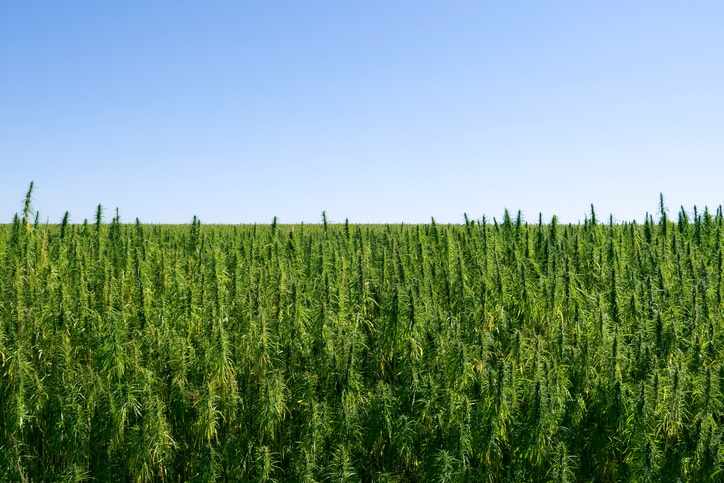20 things hemp can do (or has done) to rule the world
From a small-farmer renaissance to impending legislation and court decisions, these are some of the most important hemp happenings to watch.

“No one is going to give you a permission slip to change the world,” said Josh Hendrix, business development manager for CV Sciences, the leading CBD brand at retail. “There is no road map. No one has created a hemp-derived CBD market. We’re all creating disruption and taking on risk.”
What does disruption look like? CBD alone has gone from a $93 million market in 2015 to $132 million in 2016 and is looking like at least $175 million—and perhaps as high as $200 million—by the end of 2017, according to Hemp Business Journal. And the U.S. hemp industry as a whole is estimated to grow over the next five years at 22 percent per year on average, and a whopping 360 percent at mass market retail. The hemp-based product market is estimated to be a $1.8 billion concern by 2020.
How did we get here, and what’s the potential?
The 2004 court victory by the Hemp Industries Association over the big bad Drug Enforcement Agency was yuge, not just because it allowed hemp for nutrition but because it put drug warriors on notice that nature’s most nearly perfect plant was good for more than just a buzz.
The 2008 election of President Barack Obama heralded the famed April 2009 memo from the attorney general’s office that the feds would not interfere with state laws around all things cannabis. That greased the skids for the landmark 2012 election when the good people of Colorado decided, how about a little Rocky Mountain high?
The 2014 Farm Bill provided the legal framework for states to implement hemp-growing programs, but it did not mention CBD. Only Colorado and Oregon have enacted regulations for processing and finished goods over cannabinoids—the equivalent of state-run FDA and USDA. Those two federal agencies should take note of what states are doing.
Amid all the innovation around marijuana strains, vape pens and sky-high THC levels in things like wax and shatter was the discovery and dissemination of the family of cannabinoids other than THC, most predominantly CBD, which today may actually be more controversial than get-high pot. Weird, right?
And when the going gets weird, the weird turn pro. Here’s our list of hemp happenings that, along with duct tape and Elon Musk, may actually save human civilization from itself.
Caveat: These items are all very much up in the air. Some are dependent on the politicians we elect. Others on the choices that are made in product development and marketing.
Save small family farms. It’s no secret that family farms are a dying breed. Young bucks these days aren’t so much into fixing that combine and toting that bale. But hemp is cool. Hemp is hip. Hemp holds the possibility of an economic rebirth of the American farm and small-town America. “My son is corporate, but he’s going to tend to our CBD crop this year,” said Michael “Mr. Hemp” Bowman, a hemp farmer in Colorado. “Never in a million years would he come back to grow corn. If we want to reverse the demographics in our rural communities, this is about opening the door for young people to come back.”
Treat CBD like a supplement, not a street drug. That means quality assurance/quality control; it means abiding by Good Manufacturing Practices in producing the product; it means using supplement-style structure/function claims and not drug claims that say the product can treat any disease. “Companies need to make sure the packaging, labeling and claims are compliant so you don’t give the FDA or other regulatory agencies an easy way out of coming after products,” said supplements regulatory lawyer Justin Prochnow, from the Greenberg/Traurig firm. Fellow attorney Bob Hoban, managing partner from the Hoban Law Group, concurs. “That’s the biggest problem this industry has,” he said. “CBD helps with condition X or Y—that’s a no-no. No dietary supplement has been approved for that. You can’t make those types of claims.”
Warning letters. Three times now the FDA has sent a suite of warning letters to CBD makers. They all share one common thread—unlawful health claims. The second raft of letters also featured the FDA purchasing products and testing them to see if they met label claims for CBD content. Most failed. While companies that have received letters have to respond within 15 days, the thing to do is, “simply stop doing what they were doing,” said Hoban. “Send letters to the FDA that they stopped, and there was no further action. No harm, no foul.” But Prochnow cautioned that while warning letters are a “two or three on a scale of one to 10, the next action from the FDA is an eight or nine. The next action is going to court and getting an injunction or seizure order and trying to get a company to agree to a consent decree that they will either cease operation or do things differently before going back into business again. The next step is like four levels above a warning letter.”
CBD is so 2018. But after that? For today, most hemp is grown for CBD. “The money right now is in cannabinoids,” said Andrew Graves, chairman of Atalo Holdings and a seventh-generation farmer. “In 2018 it’s CBD. But in 2019 and beyond it’s all the other cannabinoids.” But the market is leagues greater—everything from building materials to automobile dashboards and textile fibers to paper.
Um, more opioid deaths? Where some perish, others prosper, as the saying goes. Pharmaceutical makers of pain-killing opioid drugs are in the crosshairs with their overzealous marketing of these drugs, which often leads consumers to the cheaper, street-drug opioid, heroin. Dependency, death. And, it turns out that marijuana could be the answer. A provocative study published in the prestigious Journal of the American Medical Association Internal Medicine in 2014 found opiate-related deaths decreased by more than 33 percent in 13 states in the following six years after medical marijuana was legalized. As the overdose deaths continue to pile up, and research surrounding marijuana continues to come in, medical marijuana (and CBD) is looking like a solution to pain and, yes, death. This could help wavering lawmakers get on board.
Winning at Target. In October, big box giant Target said it would start selling CBD from CW Botanicals, pioneering makers of the Charlotte’s Web strain of CBD. Not two weeks later, the FDA sent a warning letter to CW for making drug claims. Target quickly announced they will not be selling CBD.
Words matter. Part of the problem that gets retailers in trouble with local law enforcement is the confusion about what constitutes pot, what’s legal CBD and what’s hemp. While all three come from the Latin binomial Cannabis sativa, marijuana’s active constituent is the cannabinoid called THC. Legal CBD needs to be derived from industrial hemp, which by law has a THC level below 0.3 percent. CBD derived from THC-high marijuana is available only in marijuana dispensaries. Hemp is the stalks, stems and sterilized seeds, while marijuana is the leaves, flowers and viable seeds. “Colorado and California have different definitions,” said Shawn Hauser, with the law firm Vicente Sederberg. “That annoys me at night. Cannabis and marijuana and hemp are not consistently used, and that causes confusion among law enforcement, regulators and consumers. Consistent terminology will help everyone understand the facts.”
Education. Raids on retailers in Indiana and North Dakota come about because local authorities—from state attorneys general to local cops—don’t understand that full-spectrum hemp oil comes from legal industrial hemp and not street-drug weed. Products are put back on shelves once authorities are educated—sometimes.
HR 3530, the Industrial Hemp Farming Act of 2017. Introduced July 28, 2017, by Rep. James Comer (R-KY) with 15 Republican co-sponsors and 21 Democratic co-sponsors, the bill would “amend the Controlled Substances Act to exclude industrial hemp from the definition of marihuana.” It is currently in various House committees and subcommittees. The Senate version may be more progressive and not give authority to the U.S. attorney general, which would make the law’s implementation more capricious depending on which political party occupies the Department of Justice.
De-scheduling marijuana from the Controlled Substances Act entirely. The war on (some) drugs started with this 1970 legislation, signed into law by President Nixon. It established five “schedules.” Schedule I drugs are the most onerous. They have a high potential for abuse, no medicinal use and severe safety concerns. We’re talking heroin, cocaine and even LSD. Most surprising is the inclusion of marijuana, despite it being legal in 29 states and Washington, D.C., for medicinal values and the FDA approving synthetic bio-identical THC molecules for use against nausea, vomiting, appetite loss and weight loss. Sixty peer-reviewed studies have been published on marijuana, with nearly seven in 10 showing efficacy, helping everything from aspects of pain and multiple sclerosis to cancer and bipolar. Some people advocate putting marijuana lower on the schedule list, say Schedule II, along with morphine, methadone and oxy. Others say take it off the list entirely, along with alcohol.
Statement of principles. File under: The Empire Strikes Back. On Aug. 12, 2016, the USDA, DEA and FDA put out a document stating that industrial hemp—despite the 2014 Farm Bill—remains a controlled substance as far as they are concerned. The Indiana state attorney general used this statement of principles as part of his rationale for issuing his own opinion that CBD is an illegal compound.
Omnibus bill. The 2017 Congressional spending bill states that as long as a hemp material is Farm Bill-compliant, no funds can be spent by the U.S. Department of Justice hindering the implementation of medical marijuana laws in states. “As long as that omnibus bill is in place," it ties the Department of Justice’s hands back," Hoban said.
New DEA code. On Dec. 14, 2016, the Drug Enforcement Agency issued a rule establishing a new drug code 7350. Drug codes are used by DEA registrants like doctors, researchers and hospitals in order to procure substances. Sounds reasonable enough; after all, these parties are all increasingly interested in researching and using these cannabis-derived substances. Problem is, the DEA proclaimed that “extracts of marihuana will continue to be treated as Schedule I controlled substances.” This defines cannabis as an illegal substance, but cannabis is not illegal—marijuana is, Hoban explained. “The DEA can’t do that as part of the drug code. We were flummoxed, to say the least.” This case is currently being considered by the liberal 9th Circuit Court of Appeals, based in San Francisco.
Source rule. This is winding its way through the courts as we speak. “The mother plant from which the cannabinoids are derived dictate whether you’re a controlled substance or not,” said Hoban. “If CBD comes from a marijuana plant above 0.3 percent THC, it’s a controlled substance, but if it comes from hemp or an exempted part of the plant or any of 25 other plants like hops or echinacea, it’s legal.” Notably, a June 2, 2017, brief filed by the DEA embraced the source rule, but where the courts come down on this remains to be seen.
FDA, a Big Pharma subsidiary. It’s no secret that the FDA believes its role is to be a gatekeeper to medicines for Americans. How do you think they feel about all those states taking citizen health into their own hands by providing for medical marijuana, which is decidedly not authorized by the FDA? Plus, as part of the federal drug warrior apparatus, the FDA is on board in trying to stuff the genie back into the bottle. Under federal law designed to protect drugs over supplements, a supplement-style ingredient can later become a drug, as with Lovaza fish oil concentrate, but once an ingredient is a drug it can never be a supplement. The FDA is considering approving a CBD isolate called Epidiolex for certain child-onset epilepsy conditions. The drug company, GW Pharmaceuticals, petitioned the FDA back in 2007 to consider it, and 10 years later, in 2017, published three small human clinical studies showing that, when all other drugs fail, CBD can help. The FDA is of the opinion that CBD sold at retail as a supplement started after GW Pharmaceuticals first informed the FDA of its plans, hence, CBD cannot be sold without prescription. This aspect was part of the most recent wave of FDA warning letters to CBD companies.
The market is faster than regulations. A way-unexpected ally on the hemp side is James Woolsey, who was director of the CIA (you read that right) under President Bill Clinton and, for a brief time, was a senior advisor to President Donald Trump’s transition team. “Politicians want to talk about their maneuvering,"said Woolsey. "We want to surprise them and get the (hemp) market growing substantially, and then we’ll smile at them and tell them what we did.” In other words, keep going, disruptors and self-care citizens. If enough toothpaste comes out of the tube, it may well be impossible to get it back in the bottle.
Come together. Perhaps the most important tactic is for all the various interests in the cannabis world—adult-use pot, medical marijuana, health food store CBD, industrial hemp for food, clothes or industrial parts, and all the other service providers from entrepreneurs who don’t touch the plant to lawyers and, yes, shoppers—is to start playing on the same team and not get stuck in their silos. “We all must work together,” said Courtney Moran, founding principal of Earth Law, which focuses on the cannabis and hemp space. “Congress is paying attention to what’s being done in these states in this developing industry. We can build an infrastructure for a long-term sustainable industry.” Hauser agrees: “What’s next for the industry is combining efforts to challenging things like the statement of principles, the federal, state and local-level laws, and local departments of health, helping them understand what’s marijuana, what’s hemp, what’s CBD and who is bound by what agency. That’s a cornerstone for the industry—education.”
A webinar on the current state of affairs in the CBD/hemp oil extract business—of great interest to retailers and producers alike—is being held Wednesday, Dec. 6. Click here to register for the free webinar, brought to you by Natural Foods Merchandiser and CV Sciences.
What is CBD, how does it work, and what’s your retail store strategy for carrying it? Answers can be found in this download.

About the Author(s)
You May Also Like




